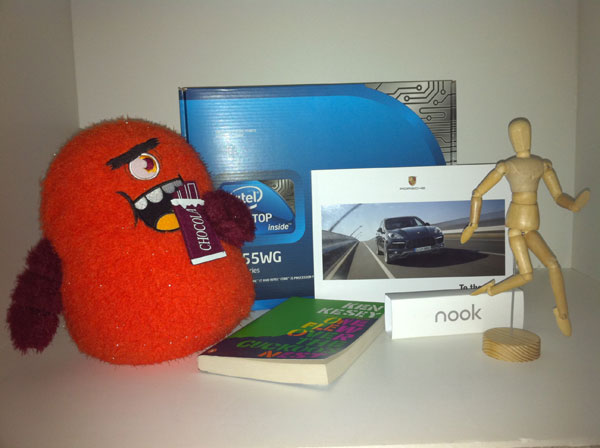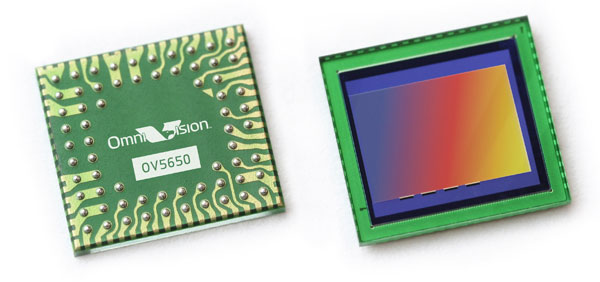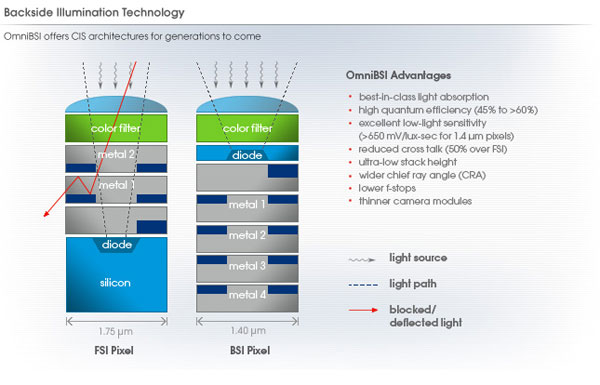Apple's iPhone 4: Thoroughly Reviewed
by Brian Klug & Anand Lal Shimpi on June 30, 2010 4:06 AM EST- Posted in
- Smartphones
- Apple
- iPhone 4
- Gadgets
- Mobile
Welcome to 2010, Apple Upgrades its Camera
The iPhone 4 is equipped with two cameras: a 5 megapixel camera with LED flash on the back of the phone and a VGA camera with no flash on the front. The LED flash works in both still and video modes. Like the EVO 4G, the iPhone 4‘s flash allows you to shoot in perfect darkness. If you’re filming a video in low light the LED will stay illuminated while you’re recording.

Taken with the iPhone 4 in total darkness
The same unfortunately can’t be said for the front facing camera on the 4. In anything but good lighting you’re going to get noise. It’s really only useful for FaceTime (or as an alternative to a mirror) and even then you need to be well lit for it to look decent.
Apple has opted for a 5 megapixel OmniVision sensor for the rear camera on the iPhone 4. What's interesting is that Apple has decided to bring backside illumination front and center with their marketing.
Backside illumination improves the sensitivity of CMOS and CCD detectors by reducing the amount of material in the path of incident light. In a frontside illuminated detector, a considerable amount of light is lost due to absorption that doesn't result in emission of an electron, in addition to reflection off pixel structures and electrical components near the frontside surface. Backside illumination greatly improves sensitivity by flipping the stack over. Instead of light having to pass through and possibly be reflected by metal structures, it is converted into electrons and read out by passing solely through silicon. Creating a backside illuminated part isn't as simple as flipping a sensor over, however, as manufacturers also generally thin the silicon light has to pass through before it can reach the photodiode. This further improves sensitivity and is generally accomplished through chemical etching in acid or by lapping (physically grinding) sensors at wafer scale.

OmniVision OV5650 - iPhone 4's rear camera SoC
Though backside illumination (BSI) improves quantum efficiency (how many photons are converted into electons), backside illumination is hugely important for another serious reason as well. Because the sensor is small at 4.6 mm by 3.4 mm, pixel size is also extremely small at just 1.75 microns square for the OV5650 in the iPhone 4 (state of the art sensors are 1.4 microns square, like those in the HTC Incredible's 8 MP sensor). Frontside illuminated parts generally have in the neighborhood of 10-15 microns of silicon before the active region of the photodiode where one wants photons to get converted to electrons. The result is that without backside illumination, pixels have a 10:1 ratio of height to length, you can visualize them as looking something like long square pillars. But that's a problem.
As photons are converted into electrons in that silicon, there's no guarantee that it will immediately travel down into the gate structure below to be read out by the camera. Electrons drift as they descend these columns, meaning that photons incident on one pixel don't necessarily map to the gate below. Because the smartphone camera sensors are so small, with a 10:1 ratio of height to size, the result is large amounts of so-called quantum blurring from electrons traveling into the gate structures of adjacent pixels. The result is a blurry image (and a decrease in MTF at the sensor level!), thus not representing the image that used to be incident on the sensor.
OmniVision and other smartphone CMOS sensor manufacturers thin that column down in an effort to come closer to having the pixel look more like a cube than a huge pillar. Ballpark numbers are between 3 and 6 microns, down from 10-15. The result is much more sensitive sensors that are higher resolution. While megapixels don't necessarily matter, neither does pixel size as much anymore; it's all about quantum efficiency, which is what engineers really care about.

OmniVision BSI - Courtesy OmniVision
The optical system of the iPhone 4 is difficult to characterize without disassembly, though the focal length is a bit shorter than previous iPhones. The result is that the photos are demonstrably wider angle. Backside illumination also allows for a bigger chief ray angle, higher numerical aperture (and thus lower f/#), but I won't bore you with the details.










270 Comments
View All Comments
macmanitou - Monday, July 5, 2010 - link
Hi Brian,great article, but one question just pops in my mind looking at the signal attenuation table, is the iPhone 3GS really the best? If yes I should really stick to it and probably just cancel the iPhone 4 order ;)
Sascha
isotropic - Monday, July 5, 2010 - link
Posted by: isotropic | 07/5/10 | 5:01 pm |This link Shows a Test phone TEMS sony/Ericsson K800i test phone (cost 2500+ Euro) being given the grip of death. A test done in a few minutes. It shows at a given point up to 16 dB losses by being held tightly as I have seen people doing it on the new iPhone. Not saying the iPhone could not have a problem, I don’t own one. But the iPhone is not alone for sure on this one. And Apple’s latest explanation seems pretty valid to me
http://www.youtube.com/watch?v=OWpGOxyEoZc&fea...
Akv - Monday, July 5, 2010 - link
I don't mind being locked in the Apple network for my iPod, because I find iTunes a quite convenient solution. However for a professionally strategic device like my cell phone, I would prefer a more independent solution.Besides, I still think it doesn't bring enough for the price. I could buy an excellent netbook for less than that price, and I would still have some money left for a simple but efficient clamshell phone.
ifartinyoutdirection - Monday, July 5, 2010 - link
It is a featurehttp://henriko.se/extern/iphone4buttonsandcontrols...
davehutch - Tuesday, July 6, 2010 - link
Your screen captures don't actually reflect what is being recorded. The video capture screen is a full-screen version that is not showing the correct ratio. the screen should be double-tapped for a tru representation and yes, the video angle of view is indeed smaller than the still image angle of view.please see my post here:
http://forums.macrumors.com/showpost.php?p=1044575...
for additional screenshots and comments.
r2d2droid - Tuesday, July 6, 2010 - link
Interesting. . . but I still want a droid.estarkey7 - Tuesday, July 6, 2010 - link
Why didn't you use Sprint's Everything plan pricing? For $99.00+$10.00 for the Evo 4g tax you get unlimited EVERYTHING, now add in tethering and see where that brings Sprint in comparison with AT&T and Verizon.Different ballgame all together, because 900 min is nothing. I talk 1200+ every month.
RadioGuru - Tuesday, July 6, 2010 - link
Hello guys. Thanks for the review. I have a quick question. Your wrote that "To generate these numbers, I measured at least 6 times and took the average"I wonder, did you convert the dBm number to linear, took the average and the recalculated the numbers back to dBm, or took the average using the dBm values. If you did the later, the numbers are completely wrong.
Your testing is better than most of what I have seen online so far, but real engineering testing has revealed that the TIS (Total Isotropic Sensitivity) of iPhone4 in Free Space is better than the 3GS, which is great!!!! but.....and here comes the big but....phamtom head testing of WCDMA 1900 TIS/TRP spec testing has shown a degradation of close to 30 to 40 dB in chamber testing. Which means a controlled lab environment...not a cowboy lab testing like the one you used. Sorry, I respect your work and I support what you do...but this time of evaluation requires far more engineering power.
in WCDMA/HSDPA systems, a call dropped is usually driven by reverse link limitaiton. Therefore engineers also consider TRP (Total Radiating Power) to measure antenna performance. in the case of iPhone4, TRP degradation due to HAND+HEAD is close to 40 dB, which will kill the call or increase drop calls or reduce data througput performance.
By the way, BAR maping using SNR makes sense for HSDPA data calls. GSM calls should use RSSI.
jacobdrj - Thursday, July 8, 2010 - link
You rock.dalebeal - Friday, July 9, 2010 - link
This is the most comprehensive review I have read - and I've read a lot of them. Thank you!